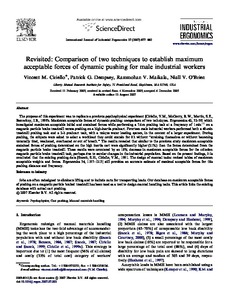Revisited : comparison of two techniques to establish maximum acceptable forces of dynamic pushing for male industrial workers

Ciriello, Vincent M. ; Dempsey, Patrick G. ; Maikala, Rammohan V. ; O'Brien, Niall V.
International Journal of Industrial Ergonomics
2007
37
11-12
877-882
manual handling ; materials handling ; maximum acceptable weight of lift ; pushing tasks
Ergonomics and work environment
English
Bibliogr.;Charts
"The purpose of this experiment was to replicate a previous psychophysical experiment [Ciriello, V.M., McGorry, R.W., Martin, S.E., Bezverkny, I.B., 1999b. Maximum acceptable forces of dynamic pushing: comparison of two techniques. Ergonomics 42, 32–39] which investigated maximum acceptable initial and sustained forces while performing a 7.6 m pushing task at a frequency of 1 min-1 on a magnetic particle brake treadmill versus pushing on a high-inertia pushcart. Fourteen male industrial workers performed both a 40-min treadmill pushing task and a 2-h pushcart task, with a unique water loading system, in the context of a larger experiment. During pushing, the subjects were asked to select a workload they could sustain for 8 h without “straining themselves or without becoming unusually tired, weakened, overheated or out of breath.” The results revealed that similar to the previous study maximum acceptable sustained forces of pushing determined on the high inertia cart were significantly higher (21%) than the forces determined from the magnetic particle brake treadmill. These results were countered by an 18% decrease in maximum acceptable forces for the criterion magnetic particle brake treadmill task, perhaps due to secular changes in the industrial population. Based on the present findings, it is concluded that the existing pushing data [Snook, S.H., Ciriello, V.M., 1991. The design of manual tasks: revised tables of maximum acceptable weights and forces. Ergonomics 34, 1197–1213] still provides an accurate estimate of maximal acceptable forces for this pushing distance and frequency."
Digital
The ETUI is co-funded by the European Union. Views and opinions expressed are however those of the author(s) only and do not necessarily reflect those of the European Union or the ETUI.